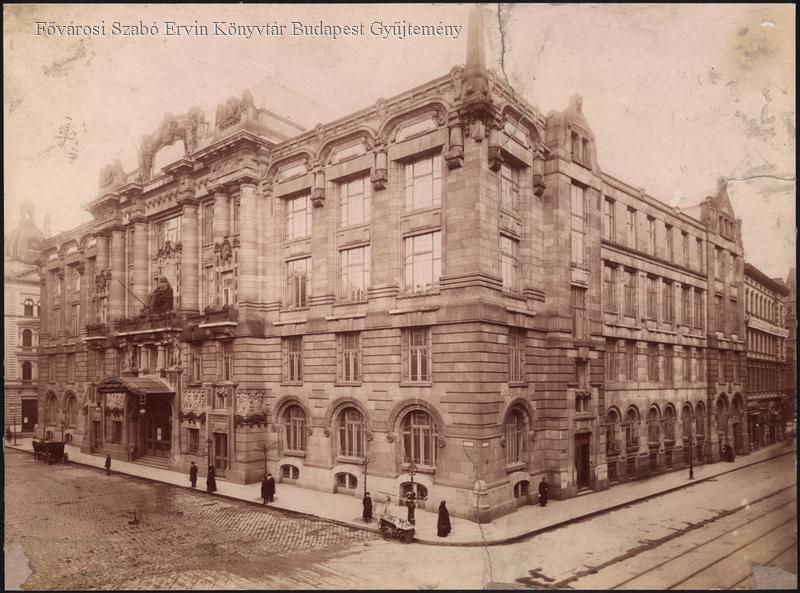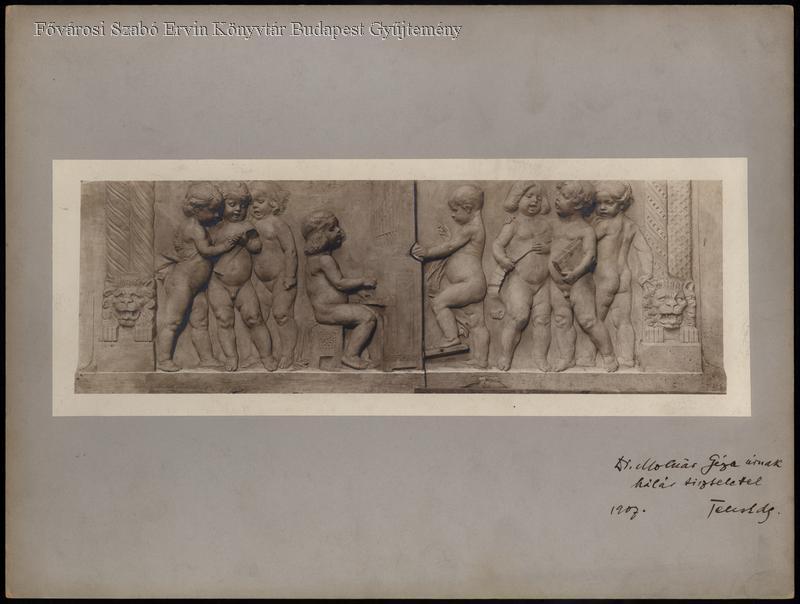The institutionalization of music was an important milestone for Hungarian culture, since
“ Music is in the blood of the Hungarian. Music has always played a significant role in our historical past, into which we have cried both our joy and our sorrow. ”
- wrote in 1907 the magazine Építő Ipar.
The idea of establishing a Hungarian music academy was first raised in the 1860s, but it took more than 10 years to implement. After several unsuccessful attempts, the parliament finally approved the motion, and in 1875 the National Royal Hungarian Academy of Music was established.

Portrait of Ferenc Liszt from the 1880s (Source: FSZEK Budapest Collection)
Ferenc Liszt, who was already internationally famous at the time, was appointed as president, Ferenc Erkel as director and Róbert Volkmann as regular teacher. Liszt and Erkel taught piano and Volkmann taught composition. The Ministry of Culture was entrusted with the administration of the institution. The ministry rented a house on the Danube-side Hal Square, on the first floor of which Liszt also lived, who held his classes in the salon of his three-room apartment. It was the first home of music education.
Ferenc Liszt's apartment in Hal Square, which was the first home of the Academy of Music (Source: Vasárnapi Ujság 12 May 1907)
Due to the dedication and reputation of the teaching staff, the institution did not have to wait long to receive a worthy building: according to the plans of Adolf Láng, their building on Andrássy Avenue, now known as the Old Academy of Music, was built in 1879.
The building of the Old Academy of Music on Andrássy Avenue (Source: Vasárnapi Ujság 12 May 1907)
The academy became increasingly popular, and due to the formation of new departments, the Neo-Renaissance building soon became too small, so the idea of building a larger palace arose. The case was important, which is shown by the fact that the theme of the competition of the Hungarian Association of Engineers and Architects in 1888–1889 was the “Concert Building Linked to the Academy of Music and Acting”. The competition was won by the young Kálmán Giergl's plan, but construction did not begin at that time.
It then took 12 years for all the conditions to be met for the idea to be implemented. At that time, the site of the palace had already been designated: on the site of today's Liszt Ferenc Square, on the plot of the Institute for the Blind, designed by Mátyás Zitterbarth Jr. in 1841. After taking over the area in 1901, they began to design the agenda of the building, and in the same year the design offices of Kálmán Giergl and Flóris Korb were commissioned to design the building of the new Academy of Music without a tender.

The building of the new Academy of Music in a photo taken after 1907 (Source: FSZEK Budapest Collection)
The plans had already been discussed in 1902, and we also know that it was the Minister's express request that the building had to be built in a modern style, but that the Hungarian elements also had to prevail. Construction did not actually begin until 1904, because the architects had to modify the plans several times until then to meet all requirements. The new building was finally handed over on 12 May 1907, in a ceremonial setting.
" The beautiful palace of the Royal Hungarian Academy of Music was inaugurated with great interest on Sunday morning at 11 a.m., in front of which lot of carriages came in the early hours of the morning, bringing the prominence of the political, social and art spheres to the opening ceremony."
- wrote the magazine Magyarország on 14 May 1907.
The Minister of Culture, Count Albert Apponyi gave a speech at the opening, and the Director of the Academy of Music, Ödön Mihalovich, also said a few words. The ceremony ran for several days, offering a number of programs for participants.

Building of the Academy of Music handed over in 1907 (Source: Fortepan / No.: 24145)
" The palace is not a conventional creation, it does not fit into any of the historical styles, but it is neither modern, nor Art Nouveau, nor even original, just the opposite of what it wanted to be."
- writes in the magazine Építő Ipar on 9 June 1907.
The façade of the three-storey building has been richly decorated, with several allegorical sculptures suggesting the purpose of the building. The most striking is the statue of Ferenc Liszt above the main entrance, made by sculptor Alajos Stróbl, but two other important teachers of the Academy of Music, Ferenc Erkel and Róbert Volkmann, also received a place in the two medallions on the façade. The two bronze portraits are the work of sculptor Géza Maróti.

Statue of Ferenc Liszt by Alajos Stróbl on the facade of the Academy of Music in a contemporary photo (Source: FSZEK Budapest Collection)
“ The most harmonious part of the exterior ornamentation of the palace is a group of children's friezes placed in four smaller fields in the main entrance line. About twenty, well-drawn and skillfully grouped child figures reminiscent of Pompeii amorets stands as an allegory for the history of music. The slender genius holding the two lutes, which expressively proclaims the purpose of the new palace, the noble goals of abstract art, in the height of the clouds, fits in with the harmonious image of the façade and serves as its artistic culmination.
- writes the Vasárnapi Ujság on 12 May 1907.


Designs of reliefs depicting the history of music, made by Ede Telcs (Source: FSZEK Budapest Collection)
An important innovation of the building was the use of reinforced concrete elements, in the distribution of which engineer Szilárd Zielinski played an important role. He also proposed this technical innovation for the building of the Academy of Music, which was still so unusual at the time that Zielinski had to guarantee the durability of the structure.

The Great Concert Hall of the Academy of Music (Source: FSZEK Budapest Collection)
The small hall of the Academy of Music from 1907 (Source: Magyar Pályázatok, 12 July 1907)
Through the extremely accentuated main entrance, you could enter the spacious 15-meter-wide foyer, which was really richly decorated. On the ground floor is the book and music store, as well as the 1,050-seat concert hall with a platform designed for 250-300 participants, above which the ornament of the institute, the organ, which cost 54,000 crowns, was placed. The first floor could be accessed from here via the two main stairs. On this level is a small concert hall with 500 seats, intended primarily for piano-, chamber-, concert- and opera performances, as well as board rooms and a meeting room.
On the second and third floors were the classrooms of the institute, on the latter level were the three servants 'and secretaries' flats, and in the attic were created spacious spaces for organ, dance and fencing lessons.

The building of the Academy of Music today (Photo: Balázs Both / pestbuda)
The most famous craftsmen of the era worked on the building. The glass windows were made in Miksa Róth's workshop, the ceramic elements and the so-called the staircase ceramic spheres painted with labrador glaze came from the Zsolnay factory. The pictures entitled "Church Music" and "Secular Music" on the ground floor, as well as the fresco in the upstairs lobby, "The Source of Art", were painted by Aladár Körösfői-Kriesch. The frieze depicting the folk scenes of the Great Hall is the work of István Gróh.

The entrance to the Academy of Music today (Photo: Balázs Both / pestbuda)
The Academy of Music already had 20 full-time and 18 extraordinary teachers in the year of its opening, and each instrument had an instructor. The number of students varied from year to year: in 1907, the school year began with 520.
" The teaching system consists of five courses: the preparatory, the academic, the opera, the music teacher training and the related practice school courses."
- the magazine Ország-Világ wrote about the system of education in 1907 on the day the handover of the new building.

Ferenc Liszt still guards the entrance to the Academy of Music (Photo: Balázs Both / pestbuda)
During the stormy decades of the 20th century, the building more or less managed to retain its original condition: the ground floor and upstairs foyer and the library and the furnishing of the director's meeting room also retain their original 1907 condition. However, the large hall and the small hall (now called the Solti György Chamber Hall) underwent a more serious transformation as a result of the devastation of World War II. Despite the changes, the Academy of Music is still one of the most magnificent buildings in the capital.
Cover photo: Balázs Both/pestbuda.hu




































Hozzászólások
Log in or register to comment!
Login Registration